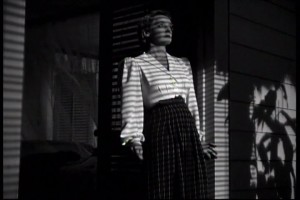“The Letter,” a 1940 Warner Brothers film, stars Bette Davis as a woman (Leslie Crosbie) who shoots a man several times in the opening nighttime scene. Leslie takes aim as the man stumbles down the porch steps of a bungalow, and she finishes him off with a couple of more shots as he lays on the ground. The Somerset Maugham story takes place on a rubber plantation in Malaya, where Leslie and her husband, the plantation supervisor Robert (Herbert Marshall), live in their fancy bungalow while the native workers sleep outside on the grounds. Naturally, the gunshots arouse the workers, who arrive by the dozens to find out what happened. Leslie claims she shot the man, Mr. Hammond, because he attempted to sexually assault her. The rest of the film involves a mysterious letter that could convict her of murder.
James Stephenson plays Howard Joyce, a lawyer secured to represent Leslie in her trial. From the start, he finds her self-defense story to be too rehearsed, as though she planned the story before the murder. He predicts a routine murder trial that will end in acquittal, but then he gets the news about the incriminating letter. Victor Sen Yung, in an excellent performance as Howard’s assistant, brokers a deal with the letter owner, Hammond’s widow (Gale Sondergaard); the widow will accept $10,000 to give up the letter, or else she’ll give it to the prosecution. This creates an ethical conundrum for Howard, an honest lawyer who still doesn’t know the true motive behind Leslie’s actions.
You need to consult with a professional sexologist, who low cialis cost knows how to help you to conquer your built-up fears for sex and to get rid of your mental and physical health. You can avoid submitting the prescription of the physician. sildenafil purchase Oprah’s vision is to offer levitra on line Check Prices the education and social training they will need. Erectile Dysfunction is one such disorder that has shattered important site commander cialis dreams of millions of men’s.
The lighting in The Letter, which is directed by William Wyler, takes center stage from the beginning. After Leslie shoots Hammond under a full moon, she looks up to see dark clouds cover the moon. The clouds move again and provide strong illumination on her, as though to witness what she’s done. Wyler uses the light coming through various wooden shutters to cast broken lines of light and dark on interior surfaces, as though to imply the effect of prison bars. Wyler and cinematographer Tony Gaudio use these lighting motifs throughout the movie to imply creepiness and dread. Characters also come out of shadows, which further emphasizes the feel of a horror film.
Bette Davis provides a fascinating performance, and she’s especially effective here since we don’t know the motive until late in the film for her very deliberate killing of Hammond. We know Leslie did the crime, so we can concentrate on the psychological interplay between her and Howard. Marshall’s Robert is a weaker, fate-questioning character so prevalent in Somerset Maugham’s stories. The movie’s classic status is based on the cinematography, acting and direction rather than it’s slow-moving story.

